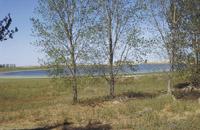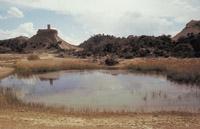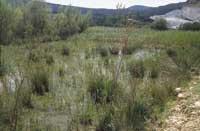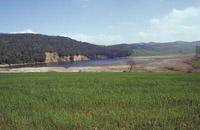Endorheic lagoons in the Basque Country
2001/01/01 Estonba Mintxero, Mikel Iturria: Elhuyar aldizkaria
As with other wetlands, in the Basque Country there are no large endorheic lagoons. However, those of little entity and depth are quite abundant in the south of Euskal Herria, especially in the Ribera navarra and to a lesser extent in the Rioja Alavesa. However, despite the abundance of wetlands of this type existing in the Basque Country, few have remained unchanged to date, since most of them have known man-made transformations that have significantly altered their natural characteristics due to high agricultural pressure and the great fragility of the area. Between these transformations two main types can be distinguished: those directly provoked in the ponds and those provoked in the surrounding lands. Among the first are the construction of dams, canals and canals; the destruction of margins by overextension of agricultural land; and the drying of endorheic cuvettes for obtaining new agricultural land. Indirect effects include eutrophication processes resulting from increased use of fertilizers and organic matter and contamination by chemicals used in farmland.
Given all this, it can be said that the situation of the endorheic lagoons of the Basque Country is quite worrying. On the one hand, although throughout history it is not possible to know the number of wetlands that have disappeared due to human influence, it can be suspected that many of the endorheic lagoons that once appeared in small buckets were drained to obtain farmland. Without going any further, they recently dried up with this objective of two endorheic lagoons, the Balpertuna, near the town of Ablitas in the Ribera de Navarra, and the Laguna del Musco, located on land of Laguardia in the Rioja Alavesa.

However, most endorheic lagoons have become irrigation lagoons or reservoirs through small dams. This modification represents an increase in the depth of the ponds and the disappearance of the drying in summer, which has significantly altered the natural characteristics of the rafts. However, this last modification is more agile than the previous one, since over time these lagoons have undergone interesting naturalization processes, becoming one of the most important wetlands in the Basque Country. Currently, the most significant examples of the endorheic ponds that are in this situation are the pond of Pitillas and the reservoir of Las Cañas. Both are Nature Reserves within the protected areas of Navarre and are included in the list of the Ramsar Convention that brings together the most important wetlands in the world. But they are not the only ones, since in the south of Navarre there are numerous lagoons and smaller reservoirs that were previously endorheic lagoons. Among them are: the El Pulguer Nature Reserve, near Tudela, the Laguna de los Dos Reinos in Figarol lands, the Laguna de Lor next to Cascante, the Laguna de Badina Escudero near Alesbes or the Cortinas reservoir in the Bardenas.
As a result, in Euskal Herria there are very few endorheic ponds that have remained unaltered and all of them bear strong agricultural pressure, since the farmland has been taken to the last extreme of them. In addition to the small endorheic buckets scattered in the south of the Basque Country and, above all, in the Bardenas of Navarra, the endorheic lagoons that have maintained to date the original natural characteristics are: In the Rioja Alavesa, the lagoons of Carralogroño and Carravalseca near Laguardia, and the pond of the same name located in the lands of Nabaridas; in Navarra, the Laguna del Juncal de Tafalla, the Laguna de Agua Salada of the lands of Tudela and the Laguna de La Mueda, next to Aibar. Among these, Carralogroño and Carravalseca are protected by the Protection Biotope of the Basque Country and are listed in the relationship of the Ramsar Convention. The Government of Navarra has declared the Natural Means of Juncal and Salt Water. The other two, unfortunately, still have no protection.

Gai honi buruzko eduki gehiago
Elhuyarrek garatutako teknologia





